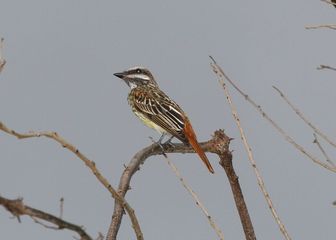Sulphur-bellied flycatcher
The most distinguishing characteristics of this flycatcher are the heavy streaking of its plumage, and its pale yellow belly. The bird also shows a rusty brown tail, and a black eyestripe. Its call sounds like noises made by children's or pet's 'squeaky-toys'.

Original source: Dominic SheronyPermission(Reusing this file)This image, which was originally posted to Flickr.com, was uploaded to Commons using Flickr upload bot on 18:02, 19 November 2011 (UTC) by Rufous-crowned Sparrow (talk). On that date it was licensed under the license below. This file is licensed under the Creative Commons Attribution-Share Alike 2.0 Generic license.You are free:to share – to copy, distribute and transmit the work
Author: Dominic SheronyPermission(Reusing this file)This image, which was originally posted to Flickr.com, was uploaded to Commons using Flickr upload bot on 18:02, 19 November 2011 (UTC) by Rufous-crowned Sparrow (talk). On that date it was licensed under the license below. This file is licensed under the Creative Commons Attribution-Share Alike 2.0 Generic license.You are free:to share – to copy, distribute and transmit the work
The Sulphur-bellied flycatcher is classified as Least Concern. Does not qualify for a more at risk category. Widespread and abundant taxa are included in this category.
The Sulphur-bellied Flycatcher, Myiodynastes luteiventris, is a large Tyrant flycatcher. This bird breeds from southeasternmost Arizona of the United States-(the Madrean sky islands region of Arizona, southwestern New Mexico, and northern Sonora, Mexico), to Costa Rica. They are short distance migrants, spending winters in the eastern Andean foothills of Colombia, Ecuador, Peru, Bolivia, and Brazil, and are passage migrants over the southern portions of Central America. More
The Sulphur-bellied Flycatcher is a large tyrant breeding mostly in southeastern Arizona in the United States, including the Madrean sky islands, as well as southwestern New Mexico, northern Sonora in Mexico, and Costa Rica. During winter months, this species will migrate short distances southward to Colombia, Ecuador, Peru, Bolivia and Brazil. The preferred habitat of the Sulphur-bellied Flycatcher includes forests in canyons. Nests are typically abandoned woodpecker holes in trees or existing cavities. More
Sulphur-bellied Flycatcher at Bodega Bay This morning I was leading an ornithology class field trip to Point Reyes. It was clear and windy and birds were scarce although we managed to see a Bobolink at the lighthouse parking lot. After returning from the Fish Docks I found a note on my car from Cindy and Leslie Lieurance saying "...a Sulphur-bellied Flycatcher or better is at Owl Canyon this AM. More
Sulphur-bellied Flycatchers usually occur in woodlands of montane canyons, at elevations between 1000-2000 meters. They make a cup nest in a tree cavity or old woodpecker hole. The female lays 2-4 eggs. They wait on an open perch usually rather high or on top of the tree and fly out to catch insects in flight-(hawking). They will also take berries and seeds. More
Sulphur-bellied FlycatcherMyiodynastes luteiventris Order PASSERIFORMES – Family TYRANNIDAE Issue No. 475 Authors: Lowther, Peter E., and Douglas F. Stotz * Articles * Multimedia * References Courtesy Preview This Introductory article that you are viewing is a courtesy preview of the full life history account of this species. The remaining articles (Distribution, Habitat, Behavior, etc. More
This Sulphur-bellied Flycatcher is just one example of over 900 WhatBird.com illustrations available for licensing. All illustrations are hand drawn and provided in Photoshop 300 dpi, layered, 2400 x 3000 pixels, 24 bit color format. See below for available formats for this product. For custom or non standard uses of our of our illustrations go to this link and fill out the form at this link: http://www.whatbird.com/illustrationlicensing/ A representative will contact you within 48 hours. More
Sulphur-bellied Flycatcher videos on the Internet Bird Collection Sulphur-bellied Flycatcher photo gallery VIREO Photo-High Res-(Close-up) Didn't find what you were looking for. Need more information for your travel research or homework? Ask your questions at the forum about Birds of Bolivia or help others to find answers. This article is licensed under the GNU Free Documentation License. More
Sulphur-bellied Flycatcher - Myiodynastes luteiventris - - RANGE: Breeds from southeastern Arizona to Central America. Winters in South America. STATUS: Fairly common. HABITAT: Inhabits riparian mountain canyons, from 5,000 to 7,500 feet in elevation, where sycamore, oak, walnut, Arizona cypress, and pine are common. SPECIAL HABITAT REQUIREMENTS: Natural cavities in trees or abandoned northern flicker holes. More
The Sulphur-bellied Flycatcher (Myiodynastes luteiventris) is a summer resident of extreme southeast Arizona. There are a handful of records in west Texas as well. The top two shots on this page were taken in the Huachuca Mountains, Cochise Co., Arizona, in May, 2008, with a Canon EOS 1D Mark III and EF 600mm F/4 L IS lens and 1.4X extender. 305 Loganberry Ct. More
This Sulphur-bellied Flycatcher was photographed at Sabine Woods -TOS, TX. Photo taken with a Nikkor 70-200mm EDAF-S VR f2.8 lens + Nikkor TC14E II 1.4x Teleconverter (EFL=420mm) on a Nikon D100 camera. More
Sulphur-bellied flycatchers usually arrive in Arizona on the later side of the migration schedule and therefore are one of the last of the flycatchers clan to set up nesting. The nest is situated in a cavity and is constructed atop a loose substructure of sticks and bark. The nest itself is made of finer materials such as leaves and stems. The female is the builder and she too takes on the incubation of the three or four spotted, buff-colored eggs. More
Family : Tyrannidae
Genus : Myiodynastes
Species : luteiventris
Authority : Sclater, 1859
